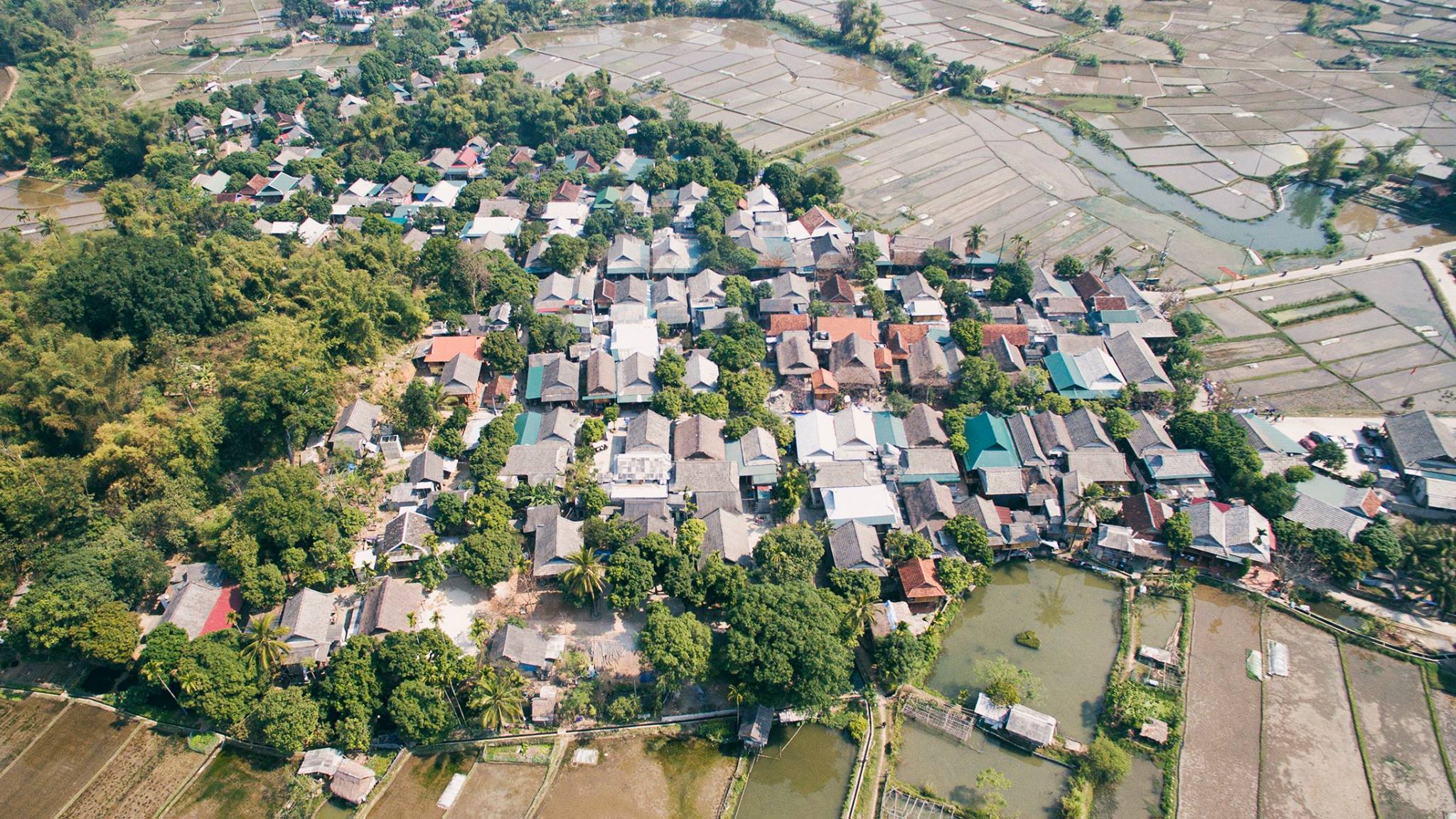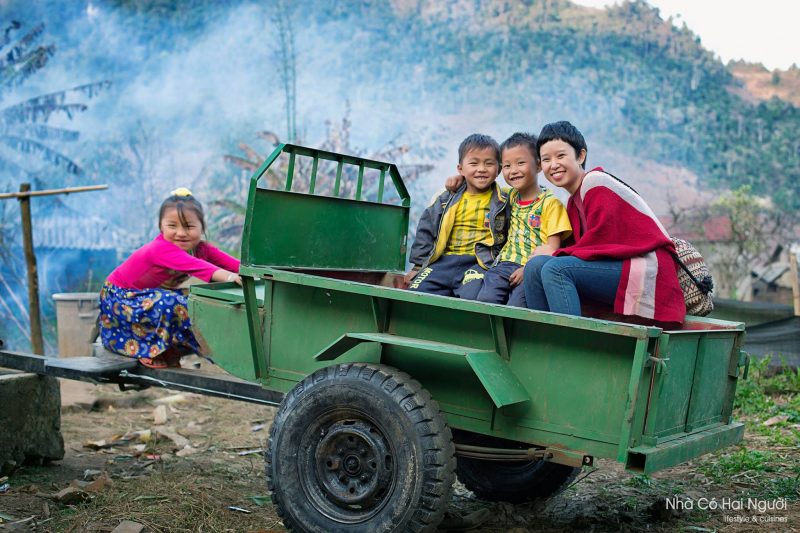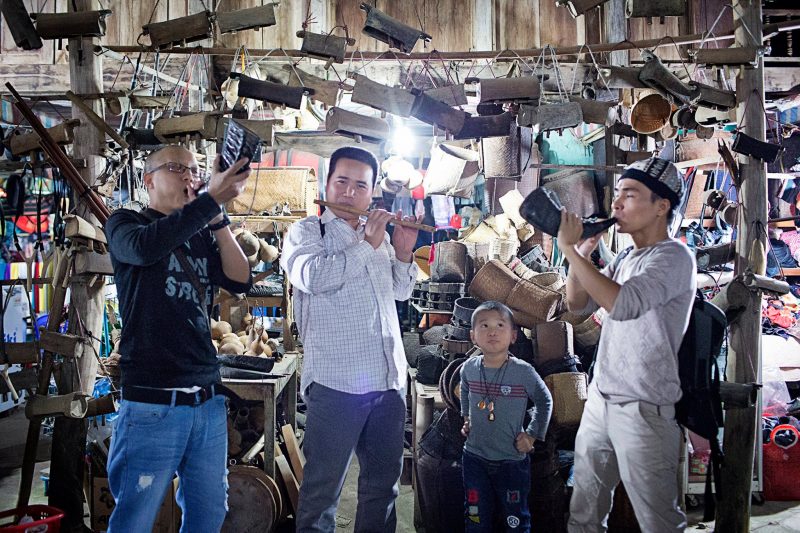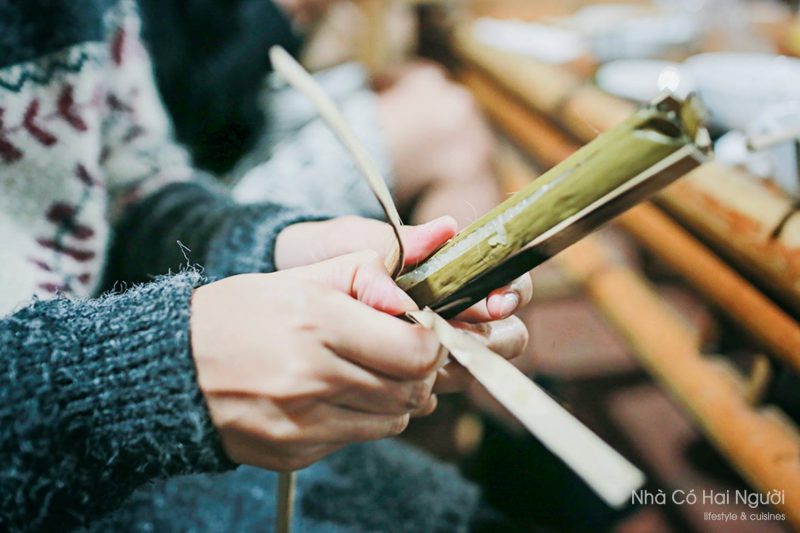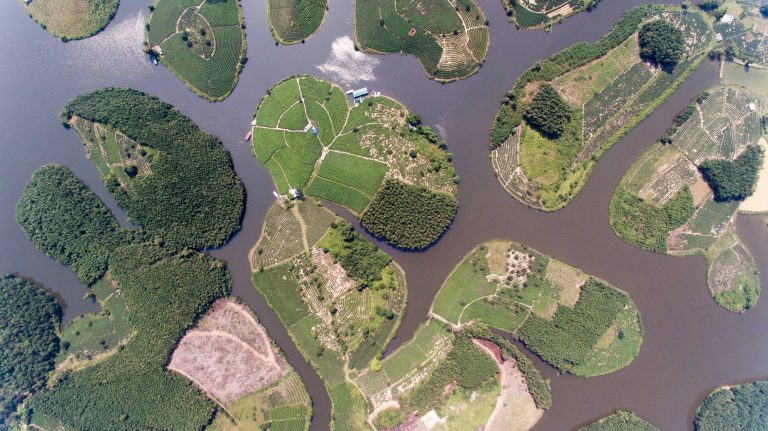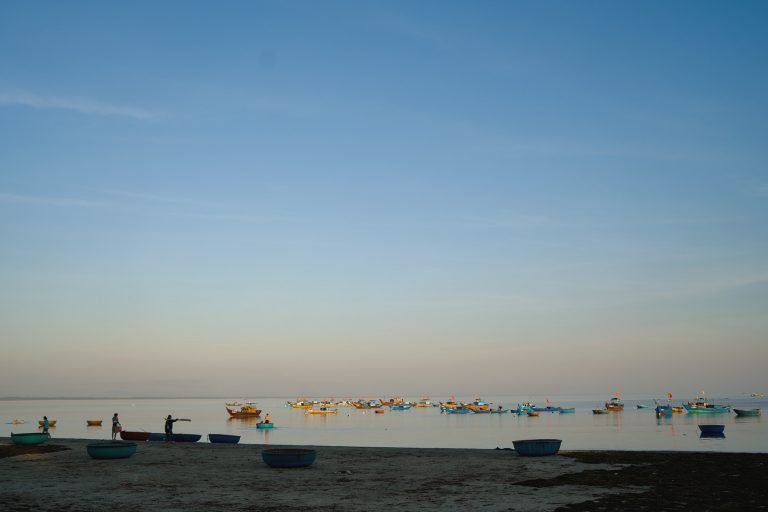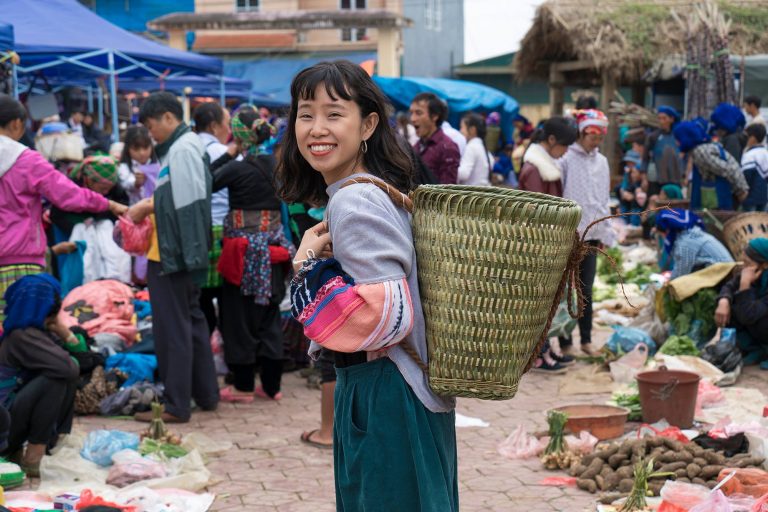The taste of Northwest-Hoa Binh
I was born and raised in the South, married to a North man. Since becoming a housemate with the “fastidious North man”, I found the cultural differences between the two regions extremely interesting, and I always wanted to learn more.
He often told me about the provinces/ cities in the Northern region that he used to visit. I was most impressed by the grandeur and the delicious and exotic dishes of the Northwest mountains. He said, “Certainly, I will take you there”.
One day, he suggested that we chose the Northwest for the spring trip 2016. From Ba Vi (his hometown), we went to Hoa Binh, Moc Chau, and Dien Bien. The farther away we went to the Northwest, the more beautiful the scenery was, the closer to nature the human lifestyle was and the stronger the food’s flavor was.
I will tell you little by little, the first destination would be Hoa Binh!
That day was the 4th day of Lunar New Year. From Ba Vi, his hometown, we went to Lac village – Hoa Binh by car. Mr. Yen – my husband’s cousin, was then the head of Van Sa village, Tan Hong commune. In addition to the work related to the village and the commune, his main job was to drive the car around to take – pick the village people who worked in other provinces, or people who lived in the provinces to visit the hometown.
I remember, every time he picked us up at the airport, he always took his currently-4-year-old son with him. All the time, no matter where the car was going, no matter what people were talking, the kid always slept soundly and comfortably. On the way, he sometimes woke the kid and teased him, “Come on, come on! I took you along to talk for fun, but you’re sleeping like that? The view is beautiful! Wake up, dear!”
The day he took us to Hoa Binh, he did not forget to take his kid along. My husband and I, two other friends, Mr. Yen and the four-year-old boy-who-always-sleeps-in-the-car – a total of “6 guys in a car”. It took us 3 and a half hours to arrive, including the time we stopped in the middle of the road to take photos in the places with beautiful scenes that we could not keep us from taking photos.
Lac Village is located in Mai Chau district, Hoa Binh province, surrounded by limestone cliffs.
When I first came to the village, I thought that this place was already commercialized, because all the people in the village were doing stilt-house homestays, restaurants or trading handicrafts. But after staying in one of the homestays with a Thai owner who spoke a bit of Kinh language and walking around the village, my feeling was a bit different.
This place is indeed a place for tourists, but the hustle and bustle were brought by the urban people. As for the villagers, they do business, but they are very gentle and honest. There is no suspicion in their sayings. There is no doubt in their eyes. There is no rush in their actions. Every day in Lac village, life is peacefully passing by in its own way.
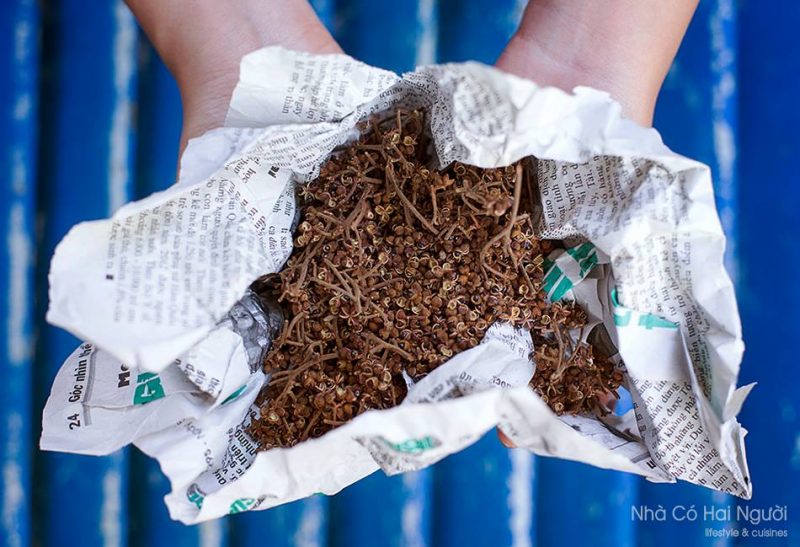
Above is the image of mắc khén seeds – a typical cooking ingredient in the Northwest.
This seed is also called forest pepper because when you taste each of the mắc khén seed, you will see the bite on the tip of the tongue. And I call it the soul of Northwest cuisine. Most of the dishes here use mắc khén as a seasoning. Especially with grilled meat or fish, if lacking the aroma of mắc khén, it won’t be delicious anymore.
Mắc khén grows in clusters. It is picked, dried, roasted on a hot pan, and crushed into a powder form, then stored in tightly covered jars to prevent from losing its fragrance. You can find bottled mắc khén powder available from the Northwest specialty websites.
This mắc khén was given to me by my homestay’s owners in Moc Chau. At first, I asked them to help me to buy mắc khén, but she said that her daughter had dried these seeds for her to cook for the guests; people also sold it in the markets, but that type was not as fragrant. They said they couldn’t give them to me, because they couldn’t cook good food without mắc khén, but they would divide some for me. I was going to refuse, I would look for buying it later, but before I could speak, she finished packing the bag of mắc khén for us in a small newspaper package. I was very grateful to them!

In Lac village, we spent the nights on stilt house No. 7. There were two types of stilt house:
1) Room with a bed for 1-2 guests who want to stay privately, but the area was very small, and not airy.
2) Spacious floor with enough area for 30-40 people sleeping on the mattresses next to each other. Shared bathroom and toilet which were located near the kitchen area and the host’s accommodation.
After dinner, Mr. Yen and the kid went back to Ba Vi, there were 4 of us left. That day, there were only a few groups on the stilt house, so the hostess let us rent the large floor for 400,000 VND/ night. I asked for the price in the neighboring houses, so I told her “Sister, is three hundred VND ok?”. She happily said it was ok and then led us up, pointing to the mattresses and blankets stacked on the corner of the floor, “here, you can spread the mattresses to sleep. Put your luggage here. Only the front door can be locked, so when you go out, lock it, go out from the back door, the stairs of that side are only accessible by family members. Don’t worry about losing your belongings.”

We told the hostess to make dinner for us. While waiting for dinner, our group wandered around Lac village. At night, though there were many tourists, it was quite peaceful. There were many stalls selling brocade (shirts, bags, wallets, hats, scarves, etc.) with extremely soft prices.
I love shopping so when being in the middle of the brocade paradise with beautiful colors and cheap price, I was so excited. I insisted my husband on buying me a backpack, a wallet, and a blue pao ball (quả pao). I gave him a cream-brown brocade hat (his favorite color).
In this picture are the lowlanders like us, who came up there to rent ethnic costumes and went out, taking photos, and shopping around the village.

The men lingered for a long time at the stall selling horns, flutes, drums, gongs, rattles, calabash pots, bird-shooting guns, bamboo baskets, forest knives, etc. I do not love these items like them. But if I hadn’t been afraid of buying too many things to continue my journey, I would have taken all of these items home. These would be great for home-décor!

At night in Lac village, in addition to shopping, dining in the surrounding houses is also an interesting experience. However, we told the hostess to cook, so we did not come to any other house. After dinner, we went around for another round and saw that family had smoked buffalo (trâu gác bếp) (the favorite dish of my husband and me), so we called 2 skewers for 4 of us to eat.
Smoked buffalo is a typical dish in the Northwest. The outside is dark brown or black but each fiber inside is bright red.
I heard a Dien Bien friend said that since ancient times, ethnic minorities had made smoked buffalo by taking large pieces of buffalo meat and then hanging them on a hot charcoal grill in the kitchen, letting the meat dry out. Later, Kinh people studied and then did not hang meat in large pieces but cut into small pieces to taste, add pepper, chili, and other spices to marinate the meat before hanging to create a rich flavor for each meat fiber.
Normally at home, smoked buffalo was delivered in the frozen form so before eating, we thawed it with a microwave. Here, the host brought two buffaloes skewers into the kitchen soaked in warm water to soften and pounded fresh ginger to mix with buffalo meat, and brought to us.
The smoked buffalo is best when served with chẳm chéo, but maybe the host was afraid that the tourists were not used to chẳm chéo, so he gave us a plate of chili sauce.
Not mentioning the dipping sauce, I must say, the smoked buffalo meat there was better than the type we used to ask my husband’s sister to order and ship from Hanoi to the South. Buffalo meat was soft and sweet with a smoky smell and a strong chili-pepper taste.
Besides smoked buffalo, around the village, there were many other options such as mountain goats, grilled stream fish, grilled corn, and bamboo-tube rice.

That evening, the hostess of Stilt house no. 7 prepared a huge dinner for us. She said, “Thankfully, there was a big group coming. I slaughtered a black pig (lợn mán), just enough to prepare a tray more for you.”
Her tray of rice had 5 main dishes made from the black pig: blood pudding (tiết canh), boiled offals (lòng luộc), steamed pork, pork with fragrant leaves grilled over charcoal (thịt lợn kẹp mắc mật nướng than hoa), and False dog-meat dish (giả cầy), served with a plate of salt and pepper mixed with aromatic seeds (hạt dổi). There were also raw vegetables, boiled mustard greens, stir-fried green beans with garlic. And a bowl of vegetable boiling broth. That was enough for 6 people of us to eat until full. The meal costed 800,000 dongs, about 133,000 dongs/ person.
Hoa Binh black pig is a highland pig, raised with corn bran, rice bran, and vegetables. The meat is soft and sweet, the fat is non-greasy, and especially the black skin is not too thick and not too thin, but very crunchy.
In addition to the dishes above, the following dishes are also listed in the Northwest specialties list: stewed pork with spices (lợn nấu rựa mận), stir-fried pork with lemongrass and chili (lợn xào sả ớt), and pork bone soup with bamboo shoots (xương lợn nấu măng)… Now I am craving again because I didn’t have enough time to try all the dishes that the hostess told me about, and I had to wait for the next time to try them.

After eating, we went around. Music teams in the village came to some houses to dance and sing. We stopped for a moment to watch. The dances were generally nothing special. But I liked the innocence of the ethnic people in each shrugging, turning their hands, even their eyes looking at each other. When I got back to the homestay, I saw the other guests gathering on the floor next to our floor, watching a show. I heard if you go in a large group, you can invite the performance team to your place to watch them perform and join some dances with them with about 700 – 800,000 dongs for 1-2 hours of performance.
The bamboo-tube rice (cơm lam) of Muong ethnic people in Hoa Binh is well known as a kind of rice made from Hoa Binh upland sticky rice whose grains are small and sticky. Glutinous rice is thoroughly washed, soaked overnight, tightly squeezed inside fresh bamboo tubes whose inside have a type of pure water, then added with a little stream water, plugged with banana leaves, then put around a charcoal fire and use your hands to turn until the rice is cooked into soft rice.
It is said that in the past, villagers who went working in the fields did not bring pots and pans along, so they invented bamboo-tube rice. Every time they went to the forest from early morning to late evening or had to stay overnight, they only needed to bring some sticky rice, a knife, a stone, and a spark ignition, whenever hungry, they stopped to eat. Later, bamboo-tube rice was not only popular but also became a specialty dish, easily found everywhere along the Northwestern regions.
The seller uses a knife to cut one end of bamboo tubes and when eating, each person removes the bamboo outer shell, dividing the rice into pieces, and eating with sesame and salt. The day we ate bamboo-tube rice in Lac village, the rice was not cooked directly in bamboo tubes but the sticky rice was wrapped in banana leaves and then put into the bamboo tubes, so when I ate, I smelled a very light fragrance of banana leaf, a bit like the crust of steamed sticky-rice long cake (bánh tét). On the other day, we ate bamboo-tube rice in Sapa and grilled skewers, after separating the bamboo tubes, the rice was still covered with a thin layer of paper from bamboo tubes. Eating the whole paper layer while the rice is still hot is great.

5th day of Tet. It was a rare warm day in the winter. In the morning, we woke up in a stilt house in Lac village – Hoa Binh, the two of us finally managed to get out of the warm blanket and very comfortable mattress of the homestay, folding the mattress and place it in the corner, and start our new day with bamboo-tube rice, sesame and salt, and a hot skewer. Nearly ten years since moving to Saigon, I could have such an authentic Northwestern breakfast.
Then, just like other winter days when I was in the North, I smoked a pipe tobacco (thuốc lào) (with the excuse of “preserving and promoting the national cultural identity”) and “picked up my backpack and went”, I also had to carry a bunch of stuff, which were tripod, rails, flycam, etc to walk to Mo Luong cave. Climbing up the cave entrance to see the words “Mo Luong is closed for Tet holiday until the 8th day. Hello and see you again!”, we burst into laughter, then stood at the cave entrance to take some pictures. Finally, we said “See you again, cave”, raised our hands up to say goodbye to the cave, then left to visit Pom Coong village.

Opposite the entrance of Mo Luong cave is the trail leading to Pom Coong village. In fact, Lac and Pom Coong villages are connected. But in Pom Coong, there were fewer houses doing business. Mostly homestays. There were a few souvenir shops. For those who like tranquility, Pom Coong is a suitable choice. From there, you can walk to Lac village to eat, drink and shop.

